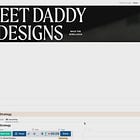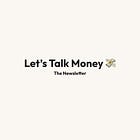When I first launched this newsletter, I shared my thoughts on why I chose Substack, despite my growing frustration with marketing my business. After writing on this platform for a few months, I've decided to fully transition from Flodesk to Substack for the foreseeable future. Here’s why:
Why I Started My Newsletter on Flodesk
When I began my business in 2018, the industry had tons of advice on building a newsletter, offering freebies to attract subscribers, and choosing the best email platform. Flodesk arrived in 2019 as the shiny new option with an enticing 50% discount (I mean it was a really good deal).
While using Flodesk, I set up a few essentials to keep the Sweet Daddy Designs newsletter running smoothly:
Forms: Embedded on my website to gather subscribers in exchange for freebies or opt-ins.
Workflows: I used workflows to send a sequence of emails to subscribers, often called a “welcome sequence.” These were designed to introduce new subscribers to my brand over the span of a month after they downloaded a freebie. But to be honest, I’m pretty sure I copied and pasted the same 6 or 7 emails into each workflow. I never felt excited about how they worked, and, to make matters worse, they sometimes randomly broke or kicked people out of the sequence without my knowledge—frustrating, to say the least.
Segments: A handy way to organize subscribers. I primarily categorized them based on the forms they used or whether they were designers or business owners.
Although these features were useful at first, I eventually stopped engaging with Flodesk. It felt like I was sending content into a void, with no interaction from my audience, so I stopped altogether.
What Excites Me About Substack
A few months ago, I discovered Substack, a platform that combines everything I enjoy or want to try. It offers long form content, video and audio (like podcasts), and most importantly, interaction with subscribers. It’s a blend of social media, blogging, and email newsletters.
Sign me up.
Here’s what I’ve observed after using Substack for a while:
Simplified Segmentation: Unlike typical email marketing tools, Substack only segments subscribers into “free” and “paid” categories. While I liked knowing the specifics of my audience on Flodesk, I realized it wasn’t essential. My content is useful for everyone interested in brand strategy, so losing granular segmentation didn’t bother me.
Monetization Options: Substack allows newsletter monetization, sparking debates about whether you should charge for content. Opinions vary widely—some advocate for free newsletters with optional support from readers, while others prefer primarily paid content with occasional free posts. For The Rogue Creative, I’m taking a hybrid approach: sharing valuable insights while keeping some exclusive content for paying subscribers.
Interactive Discussions: Unlike traditional newsletters, Substack allows readers to comment and engage in discussions. I love getting feedback, answering questions, and fostering conversations about design. This level of interaction builds community in a way standard email platforms can’t.
Searchability and SEO: Substack doubles as a blog, making my content discoverable on Google. This broadens my reach beyond the app itself.
Accessible Archives: Substack’s archive feature ensures my past newsletters are easily accessible. This allows new subscribers to browse past content and get a better sense of my writing before subscribing. It’s like having an online library of my work.
How I Plan to Transition Away from Flodesk
I’ve gained many of my subscribers over the years through freebies, so changing this part of my strategy isn’t something I’m taking lightly. But since Substack doesn’t have workflows, I’m planning to cut this process out entirely.
To be honest, this is a shift I’ve been considering for a while. I see my business evolving beyond serving an audience that leans toward DIY branding (which is totally fine if that’s your thing!). Instead, I want to focus more on working with people who are ready to invest in deeper brand strategy and design work. Because of this, I plan to update and re-release my existing freebies on Substack so that anyone can access them anytime.
Another reason I’m stepping back from freebies and opt-ins is that I’ve realized something important: creating quality, curated content that I’m genuinely proud of holds more value than putting together something just to get people on my list. You know what I mean? I’d rather share meaningful insights and stories that resonate with you than churn out generic content for the sake of a subscriber count.
My Goal for Substack
My approach on Substack will be different from my Flodesk days. Previously, I treated my newsletter as a pure marketing tool—announcing project spots, promoting services, and showcasing recent projects. While I’ll still do some of that, my main goal is to be less salsey and more informative and personal. I want to share my knowledge and in the process, hope you find value in what I write.
What Are Your Thoughts? Have you made a switch from one email platform to another? What’s your experience been like with platforms such as Flodesk or Substack? If you haven’t, what features matter most to you in an email marketing tool?
Share your experiences in the comments below or reply directly to this newsletter. I’m curious to know what your journey with email marketing has been like.










I love all of this, and resonate with it so deeply! I also made the switch from Flodesk to Substack this year and I haven’t looked back since
Love that you're on Substack now! Welcome <3 I've always loved your newsletter and am so excited to see more people using newsletters as more than just a marketing tool!